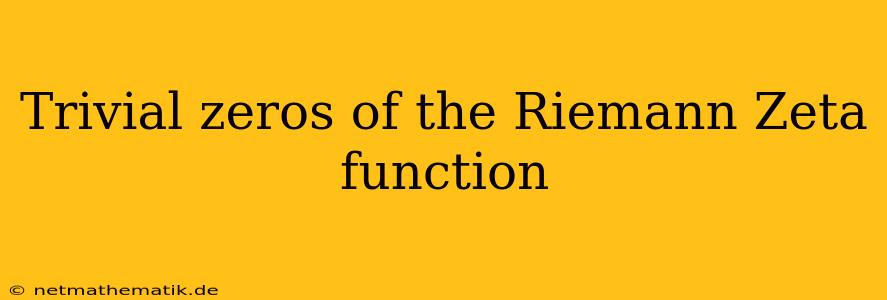The Riemann Zeta function, a fundamental object in number theory, holds a fascinating mystery in its trivial zeros. These zeros, located at the negative even integers, are not as enigmatic as the non-trivial zeros, which are believed to lie on the critical line with real part 1/2. However, understanding the trivial zeros is crucial for comprehending the function's behavior and its relationship to the distribution of prime numbers.
Understanding the Riemann Zeta Function
The Riemann Zeta function, denoted by ζ(s), is a complex-valued function defined for complex numbers s with real part greater than 1. It is defined as the infinite sum:
ζ(s) = 1/1^s + 1/2^s + 1/3^s + ...
This function exhibits remarkable properties and plays a pivotal role in various mathematical fields. Its most famous connection is to the distribution of prime numbers, as expressed by the prime number theorem. The Riemann hypothesis, one of the most significant unsolved problems in mathematics, conjectures that all non-trivial zeros of the ζ(s) lie on the critical line.
The Existence of Trivial Zeros
The trivial zeros of the Riemann Zeta function are the values of s for which ζ(s) = 0. These trivial zeros are easily identified and are located at all the negative even integers:
s = -2, -4, -6, -8, ...
This pattern arises from the functional equation of the Riemann Zeta function, which relates the values of ζ(s) to ζ(1-s). The trivial zeros are the solutions to the equation ζ(1-s) = 0, where s is a negative even integer.
Why are They Called Trivial Zeros?
The term "trivial" is used to distinguish these zeros from the non-trivial zeros. The trivial zeros are relatively simple to find and their existence is a direct consequence of the functional equation. In contrast, the non-trivial zeros are much more complex and their location is still an open question, hence the significance of the Riemann hypothesis.
Significance of Trivial Zeros
Despite their seemingly straightforward nature, trivial zeros play a crucial role in understanding the Riemann Zeta function:
- Analytical Continuation: The trivial zeros help to extend the definition of the Riemann Zeta function from its initial domain (real part of s greater than 1) to the entire complex plane. This extension is crucial for analyzing the function's behavior and establishing its connection to other mathematical objects.
- Functional Equation: The functional equation of the Riemann Zeta function is intimately connected to the trivial zeros. It relates the values of ζ(s) to ζ(1-s), and the trivial zeros are the solutions to ζ(1-s) = 0. This equation is fundamental for understanding the symmetry and properties of the Riemann Zeta function.
- Connection to Prime Numbers: Although trivial zeros are not directly related to the distribution of primes like the non-trivial zeros, they play a role in understanding the underlying structure of the function. They contribute to the overall behavior of the function, which in turn impacts its relationship to prime numbers.
Conclusion
The trivial zeros of the Riemann Zeta function, though seemingly insignificant compared to the non-trivial zeros, are essential for a complete understanding of this important function. Their role in analytical continuation, the functional equation, and the underlying structure of the function highlights their importance in number theory. While they may not hold the same mystique as the non-trivial zeros, they are an integral part of the Riemann Zeta function's fascinating landscape.
